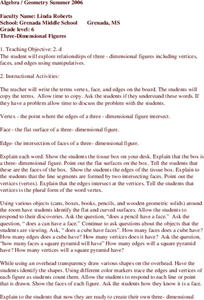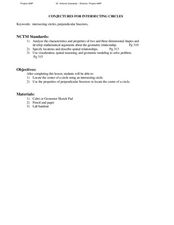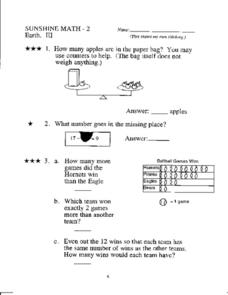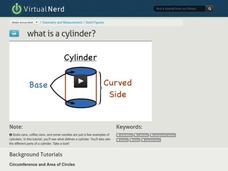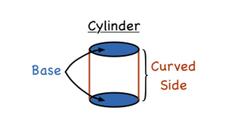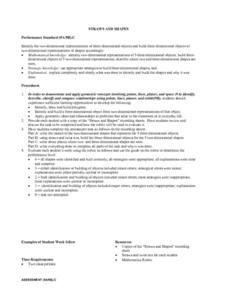Three-Dimensional Objects Teacher Resources
Find Three-Dimensional Objects lesson plans and worksheets
Showing 463 resources
Krista King Math
Nets of Pyramids
An instructional video shows how to create nets for different types of pyramids. The instructor demonstrates the variation in the net as the type of base changes.
World Wildlife Fund
Arctic Shapes
In a two-part worksheet, young geometers examine 3-D shapes and describe their attributes in a table. They will be able to draw the shape and name the number of vertices, faces, and edges. In the second part, individuals explore...
101 Questions
Sticky Stickies
Don't let your classes get stuck on area calculations—grab their attention with an inquiry-based lesson! Scholars must develop a plan to determine how may sticky notes it takes to cover the surface of a door. They decide on the...
Get Chemistry Help
Chemistry Lesson: Polyatomic Ions
Lead the way in naming polyatomic ions and have fun at the same time. Pupils learn the rules for naming polyatomic ions, primarily oxyanions. They learn patterns to determine the charge of an ion and when to add a hydrogen molecule to an...
Curated OER
Three-Dimensional Figures
Sixth graders explore three-dimensional objects. Using various objects found in the classroom, they identify faces, edges, and vertices of objects. Students create their own objects. They describe the polydron, telling the faces,...
Curated OER
An Introduction to Measuring Theory
Learners investigate one, two and three dimensional objects. In this algebra lesson, students differentiate between different shapes of objects and write equations to represent each. They start with what they already know and prove...
Curated OER
Incomplete Plans
Students practice constructing a building utilizing snap cubes and an incomplete building plan and draw the missing view. They identify and compare relationships in two and three-dimensional representations/objects. Each student explains...
Curated OER
Identify Faces
In this solid shapes activity, students learn to identify solid shape faces. Students identify the solid shapes and the faces in the six word problems.
Curated OER
The Louis Vuitton Project, using 3rd degree equations
Students model three-dimensional objects using cubes. In this geometry lesson, students calculate the volume and derived the amount mathematically. They use different objects to create two and three-dimensional objects.
Curated OER
Swirling, Twirling, Glistening Jewels... Glass Art In Words
Students examine the art form of the glass sculpture. After viewing a three dimensional object, they write creatively describing the object through the use of metaphors. They use peer editing to check for grammatical and spelling errors.
Curated OER
Conjectures of Intersecting Circles
Learners make conjectures of intersecting circles. In this geometry lesson, students observe circles and their position in space. They investigate and observe two and three dimensional objects.
Curated OER
Platonic Solids
Students identify different types of polygons. In this geometry lesson, students differentiate between convex and regular shapes. they identify the names of two and three-dimensional objects.
Curated OER
Solid Shapes challenge
In this recognizing shapes worksheet, students identify the pictures that have round or rectangular shapes, count each shape, and write the total numbers. Students solve eleven problems.
Curated OER
A Cone and Its Net
Create and investigate nets for solid shapes with your class. They identify the different parts and faces of each polygon and solid then calculate the surface area and volume of cones. They use circle sectors of varying sizes to build...
PBS
Surface Area and Volume
You and your class will like this lesson on using visual models to relate the volume and surface area of solid shapes. Learners construct three-dimensional forms using nets. They calculate the surface area and volume for each and then...
Curated OER
3D Computer Imaging Class: Cross-Section Lesson
Students use 3-dimensional materials to create a simple 3-D object. They think about different ways the object could be sliced. Students choose one way to slice the object, and draw the sliced shape on paper or computer. Using a 3-D...
Curated OER
Sunshine Math-2
In this math skills learning exercise, students use a variety of math skills to answer the 8 questions on this learning exercise. The questions deal with weight, basic algebra, measurements, math puzzles, telling time, 3-D objects,...
Curated OER
Geometry Journal: Classifying Solids
In this geometry worksheet, 10th graders respond to journal prompts related to prisms and classifying solid shapes. The two page worksheet contains nine questions. Answers are included.
Curated OER
Shape All Around
Pupils investigate solid shapes. In this geometry lesson, students take pictures of solid shapes and classify their pictures according to the vocabulary terms: edge, face and vertex. Pupils present their findings to the class.
Curated OER
Geometric Shapes, Construction Perspective
Learners examine three different geometric solid shapes and their nets. They answer multiple choice, spatial awareness questions where they determine which view: front, top or either, the net represents.
Curated OER
What is a Cylinder?
Follow along as the instructor explains what makes a solid shape a cylinder. Yes, learning the meaning of these terms: cylinder, base, curved side, curved face, congruent bases, solid, three dimensional, area, circumference, parallel,...
Curated OER
What is a Cylinder?
Follow along as the instructor explains what makes a solid shape a cylinder. Yes, learning the meaning of these terms: cylinder, base, curved side, curved face, congruent bases, solid, three dimensional, area, circumference, parallel,...
Curated OER
The Android Factory
Pupils explore the idea that primitive virtual 3D objects can be reshaped to infinitely original combinations using additive and subtractive methods. They create 3-D objects with a computer which necessitates a cooperation of right-brain...
Curated OER
Straws and Shapes
Students investigate the concepts related to observing two dimensional objects. They also build three dimensional objects using the two dimensional objects. The students give an oral or written explanation for how the pieces fit together...






